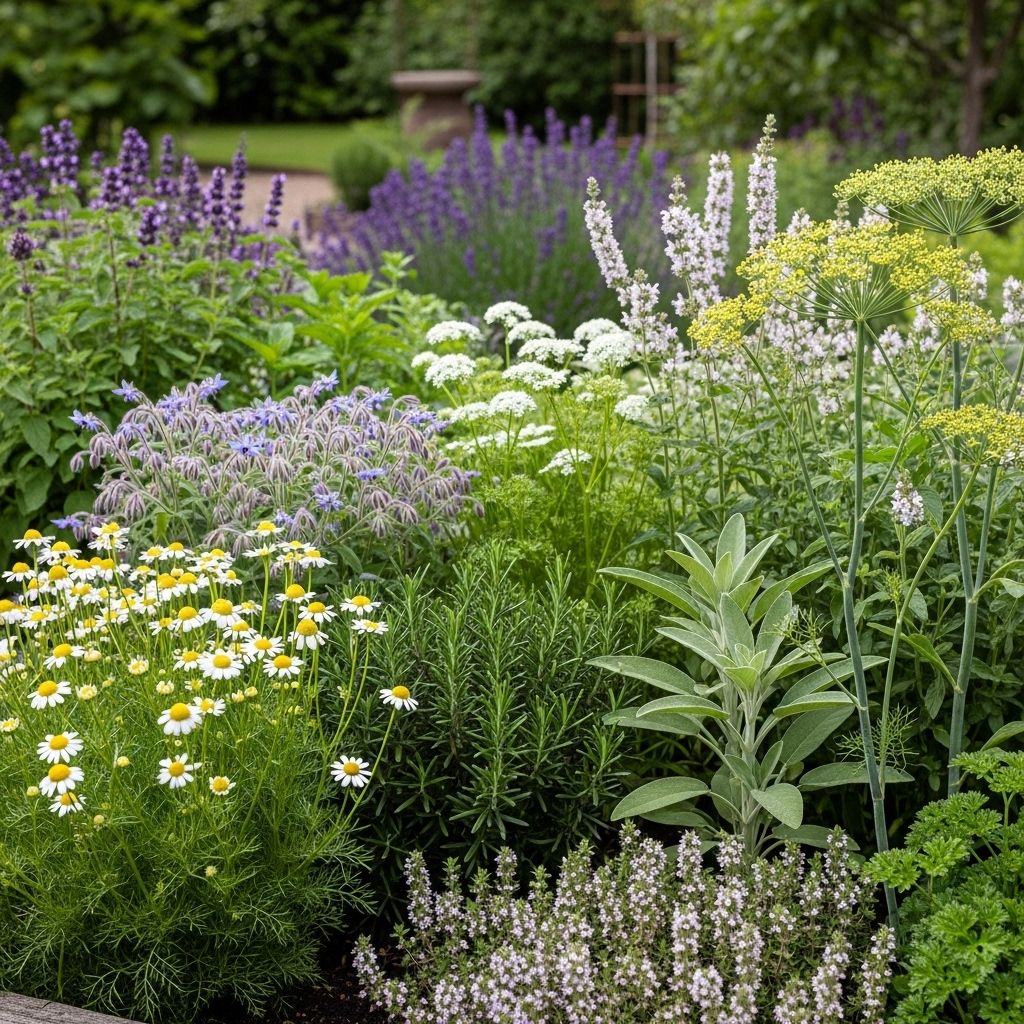17 Herbs With White Flowers: Aromatic Beauty for Your Garden
Soothing petals lend flavor to dishes while supporting an ecosystem of pollinators.

Image: HearthJunction Design Team
Herbs with white blossoms bring a unique elegance and fragrance to any garden space. Their lush foliage, delicate flowers, and edible qualities make them gardener favorites. From classic culinary seasonings to medicinal delights, these 17 herbs with white flowers offer myriad uses for both your kitchen and ecological garden health. Whether you’re building a sensory-rich moon garden or want to entice pollinators, these herbs are a delightful addition.
Why Choose White-Flowering Herbs?
White-flowering herbs enliven gardens in subtle yet striking ways. By reflecting moonlight, their blooms brighten evening strolls and dawn breakfasts. Many species pack edible leaves and petals with splendid aromas, adding dimension to both gardens and meals. Importantly, they also:
- Attract pollinators like bees, butterflies, and beneficial insects
- Provide edible flowers and aromatic foliage for culinary inspiration
- Complement vegetable beds by improving biodiversity and crop pollination
- Add low-key elegance to formal or cottage gardens
Design a moon garden with a border of these white-flowering herbs for enchanting tea parties or restorative evening peace; their light petals truly shine at dusk and dawn.
Growing and Caring for White-Flowering Herbs
These herbs thrive with basic care and minimal fuss. Most prefer:
- Well-draining soil
- Full sun to partial shade, depending on the species
- Consistent but not excessive watering
- Occasional harvests to encourage bushier growth and new blooms
Some herbs—such as watercress—even thrive in partially aquatic or damp conditions, broadening your garden’s habitat diversity.
The 17 Best Herbs With White Flowers
Let’s explore 17 superb white-flowering herbs, including both well-loved kitchen staples and some that might surprise you:
- German Chamomile (Matricaria chamomilla)
- Classic, daisy-like white petals and sunny yellow centers
- Grows easily in most gardens
- Uses: Calming herbal teas, sleep aids, dried flower bouquets
- Genovese Basil (Ocimum basilicum)
- Famed for large, aromatic leaves and spikes of tiny white flowers
- Essential Mediterranean herb
- Uses: Pesto, salads, pizza, herbal garnishes
- Greek Oregano (Origanum vulgare subsp. hirtum)
- Profuse clusters of small white blossoms
- Resilient perennial herb
- Uses: Italian, Greek, and Mexican dishes
- Cilantro/Coriander (Coriandrum sativum)
- Umbels of tiny lacy white flowers attract pollinators
- Edible leaves and seeds
- Uses: Fresh salsas, curries, garnish, coriander spice
- Chickweed (Stellaria media)
- Spreads easily, covered in delicate star-shaped white flowers
- Soft, edible leaves
- Uses: Fresh salads, sandwiches, spring greens
- Watercress (Nasturtium officinale)
- Moisture-loving herb with clusters of four-petaled white flowers
- Grows submerged or near water sources
- Uses: Peppery greens for sandwiches and salads
- Garlic Chives (Allium tuberosum)
- Flat leaves; beautiful globes of starry white flowers in late summer
- Entire plant is edible
- Uses: Stir-fries, dumplings, herbal butters
- Yarrow (Achillea millefolium)
- Flat-topped flower heads in shades including bright white
- Feathery, fern-like foliage
- Uses: Medicinal teas, pollinator attractor, cut flowers
- Sweet Alyssum (Lobularia maritima)
- Fragrant, low-growing herb smothered in dense white clusters
- Great border plant
- Uses: Edible garnish, attracts beneficial insects
- Angelica (Angelica archangelica)
- Tall, architectural plant with umbrella-shaped, white-green flowers
- Uses: Stem candying, flavoring spirits
- Meadowsweet (Filipendula ulmaria)
- Feathery sprays of tiny white flowers
- Uses: Herbal teas, flavor for mead and desserts
- Horehound (Marrubium vulgare)
- White, woolly clusters atop square-stemmed plants
- Uses: Sore throat teas, old-fashioned candy, medicinal infusions
- White Sage (Salvia apiana)
- Iconic silver foliage with spikes of creamy white blooms
- Tolerates dry, hot soils; tough perennial
- Uses: Smudging, flavoring, drought-tolerant landscaping
- Thyme (Thymus vulgaris, some varieties)
- Creeping stems with small clusters of white to pale pink flowers
- Uses: Versatile seasoning, tea infusions
- Feverfew (Tanacetum parthenium)
- Daisy-like, bright white blooms on bushy plants
- Uses: Migraine prevention, traditional medicine
- Woodruff (Galium odoratum)
- Spreading perennial with tiny, fragrant white blossoms in late spring
- Uses: May wine, aromatic potpourri
- Self-Heal (Prunella vulgaris, white-flowered forms)
- Usually purple, but some forms feature white blooms
- Uses: Traditional medicine, wild salads
Uses for White-Flowering Herbs
Their appeal goes beyond the garden’s edge. Here’s how to incorporate these herbs into daily life:
- Edible Blooms: Top salads, pastries, or cocktails with white petals
- Herbal Teas: Dry flowers like chamomile and meadowsweet for soothing infusions
- Culinary Delights: Basil, oregano, and chives add fresh zest to savory dishes
- Medicinal Uses: Soothe coughs, headaches, and digestive woes with traditional remedies
- Attracting Pollinators: Ensure robust fruit and vegetable yields by planting near crops
- Decor: Use as fragrant cut flowers, or dry for potpourris and craft projects
Design Tips: Moon Gardens & Beyond
For a magical evening retreat, try arranging these herbs in a moon garden:
- Group by height: Tallest at the back (angelica, meadowsweet), mid-size in the middle (yarrow, basil), and creepers along the front (sweet alyssum, thyme)
- Add seating: Place two comfortable chairs and a bistro table for sunset tea among the blooms
- Emphasize aroma: Combine fragrant species like basil, thyme, and sweet alyssum for a scented welcome
Incorporate these herbs around vegetables to increase pollination and ward off certain pests naturally.
Table: Growing Requirements of Select White-Flowering Herbs
| Herb | Botanical Name | Sun Requirements | Height | Hardiness Zones |
|---|---|---|---|---|
| German Chamomile | Matricaria chamomilla | Full sun | 1-2 ft | 3-9 |
| Watercress | Nasturtium officinale | Full sun – partial shade | 1-3 ft | 3-11 |
| Greek Oregano | Origanum vulgare subsp. hirtum | Full sun | 1-2 ft | 4-8 |
| White Sage | Salvia apiana | Full sun | 3-6 ft | 8-11 |
| Yarrow | Achillea millefolium | Full sun | 2 ft | 2-9 |
| Chickweed | Stellaria media | Full sun – partial shade | 0.5 ft | 3-9 |
Herb Growing and Harvesting Tips
- Pinch back stems to encourage bushy, compact growth
- Harvest leaves and flowers early in the day for best aroma
- Rotate where you plant annual herbs to reduce disease buildup
- Allow a portion to flower for pollinators
- Air dry leaves and blossoms away from direct sunlight for best flavor retention
- For herbs like rosemary, clip 6-8″ stems just above growth nodes for optimal regrowth
Frequently Asked Questions (FAQs)
Q: Can I grow white-flowering herbs in containers?
A: Yes, many white-flowering herbs like basil, oregano, thyme, and chamomile thrive in pots—just ensure proper drainage and regular watering for healthy plants.
Q: Do these herbs attract pollinators?
A: Absolutely! Flowering herbs are magnets for bees, butterflies, and other beneficial insects, which will also help pollinate your vegetables and fruits.
Q: Are all white-flowering herbs edible?
A: Most are, but always confirm identification before consuming, especially with wild or unusual species. Some, like sweet alyssum, are usually grown for ornamental delight but are technically edible in moderation.
Q: How do I use the flowers in cooking?
A: Use fresh white blooms in salads, drinks, or desserts. You can also dry flowers like chamomile and meadowsweet for teas, or infuse edible blooms into syrups and vinegars for extra zest.
Q: What is the best way to encourage more flowers?
A: Deadhead faded blossoms and trim back leggy growth regularly to encourage repeat flowering and bushier plants, especially with fast annuals like basil and chamomile.
Inviting Life and Beauty Into Any Garden
White-flowering herbs are both practical and beautiful, offering versatile uses for the kitchen and abundant value for pollinators and garden aesthetics. Start with a couple of these aromatic gems—experiment with their culinary and ornamental charms, and enjoy years of beauty and productivity in your garden!
References
- https://www.epicgardening.com/herbs-white-flowers/
- https://www.epicgardening.com/white-sage-plant/
- https://shop.epicgardening.com/products/colorado-blend-yarrow-seeds
- https://www.tiktok.com/@epicgardening/video/7528079557971234062
- https://www.tiktok.com/@epicgardening/video/7372317577600617770?lang=en
Read full bio of medha deb












